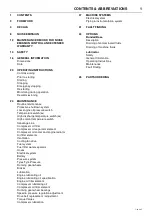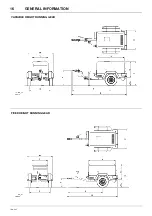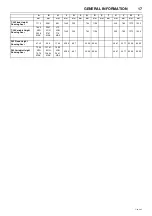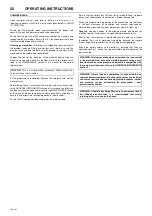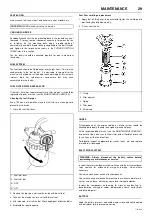
14
SAFETY
7/20, P65
The following substances are used in the manufacture of this machine
and
may
be hazardous to health if used incorrectly:
•
compressor lubricant
•
engine lubricant
•
preservative grease
•
rust preventative
•
diesel fuel
•
battery electrolyte
AVOID INGESTION, SKIN CONTACT AND INHALATION OF
FUMES.
Should compressor lubricant come into contact with the eyes, then
irrigate with water for at least 5 minutes.
Should compressor lubricant come into contact with the skin, then
wash off immediately.
Consult a physician if large amounts of compressor lubricant are
ingested.
Consult a physician if compressor lubricant is inhaled.
Never give fluids or induce vomiting if the patient is unconscious or
having convulsions.
Safety data sheets for compressor and engine lubricants should be
obtained from the lubricant supplier.
Never operate the engine of this machine inside a building without
adequate ventilation. Avoid breathing exhaust fumes when working on
or near the machine.
This machine may include such materials as oil, diesel fuel, antifreeze,
brake fluid, oil/air filters and batteries which may require proper
disposal when performing maintenance and service tasks. Contact
local authorities for proper disposal of these materials.
Battery
A battery contains sulphuric acid and can give off gases which are
corrosive and potentially explosive. Avoid contact with skin, eyes and
clothing. In case of contact, flush area immediately with water.
DO NOT ATTEMPT TO SLAVE START A FROZEN BATTERY
SINCE THIS MAY CAUSE IT TO EXPLODE.
Exercise extreme caution when using booster battery. To jump battery,
connect ends of one booster cable to the positive (+) terminal of each
battery. Connect one end of other cable to the negative (-) terminal of
the booster battery and other end to a ground connection away from
dead battery (to avoid a spark occurring near any explosive gases that
may be present). After starting unit, always disconnect cables in
reverse order.
Radiator
Hot engine coolant and steam can cause injury. Ensure that the
radiator filler cap is removed with due care and attention.
Do not remove the pressure cap from a HOT radiator. Allow radiator to
cool down before removing pressure cap.
Transport
When loading or transporting machines ensure that the specified lifting
and tie down points are used.
When loading or transporting machines ensure that the towing vehicle,
its size, weight, towing hitch and electrical supply are all suitable to
provide safe and stable towing at speeds either, up to the legal
maximum for the country in which it is being towed or, as specified for
the machine model if lower than the legal maximum.
Ensure that the maximum trailer weight does not exceed the maximum
gross weight of the machine (by limiting the equipment load), limited by
the capacity of the running gear.
Note:
Gross mass (on data plate) is for the basic machine and fuel only,
excluding any fitted options, tools, equipment and foreign materials.
Before towing the machine, ensure that:-
•
the tyres and towing hitch are in a serviceable condition.
•
the canopy is secure.
•
all ancillary equipment is stored in a safe and secure manner.
•
the brakes and lights are functioning correctly and meet necessary
road traffic requirements.
•
break–away cables/safety chains are connected to the towing
vehicle.
The machine must be towed in a level attitude (the maximum
permissible drawbar angle is between 0
°
and +5
°
from horizontal) in
order to maintain correct handling, braking and lighting functions. This
can be achieved by correct selection and adjustment of the vehicle
towing hitch and, on variable height running gear, adjustment of the
drawbar.
To ensure full braking efficiency, the front (towing eye) section must
always be set level.
When adjusting variable height running gear:-
•
Ensure front (towing eye) section is set level
•
When raising towing eye, set rear joint first, then front joint.
•
When lowering towing eye, set front joint first, then rear joint.
After setting, fully tighten each joint by hand and then tighten further to
the next pin. Refit the pin.
When parking always use the handbrake and, if necessary, suitable
wheel chocks.
Make sure wheels, tyres and tow bar connectors are in safe operating
condition and tow bar is properly connected before towing.
Safety chains / connections and their adjustment
The legal requirements for the joint operation of the breakaway cable
and safety chains are as yet unidentified by 71/320/EEC or UK
regulations. Consequently we offer the following advice / instructions.
Where brakes only are fitted:
a) Ensure that the breakaway cable is securely coupled to the
handbrake lever and also to a substantial point on the towing
vehicle.
b) Ensure that the effective cable length is as short as possible, whilst
still allowing enough slackness for the trailer to articulate without the
handbrake being applied.
Where brakes and safety chains are fitted:
a) Loop the chains onto the towing vehicle using the towing vehicle
hitch as an anchorage point, or any other point of similar strength.
b) Ensure that the effective chain length is as short as possible whilst
still allowing normal articulation of the trailer and effective operation
of the breakaway cable.
Where safety chains only are fitted:
a) Loop the chains onto the towing vehicle using the towing vehicle
hitch as an anchorage point, or any other point of similar strength.
b) When adjusting the safety chains there should be sufficient free
length in the chains to allow normal articulation, whilst also being
short enough to prevent the towbar from touching the ground in the
event of an accidental separation of the towing vehicle from the
trailer.
Содержание 7/20
Страница 9: ...DECALS 7 7 20 P65 Engine oil drain Cold Start Procedure...
Страница 18: ...16 GENERAL INFORMATION 7 20 P65 VARIABLE HEIGHT RUNNING GEAR FIXED HEIGHT RUNNING GEAR...
Страница 50: ......
Страница 51: ......
Страница 52: ......


